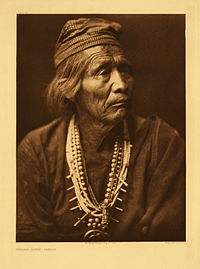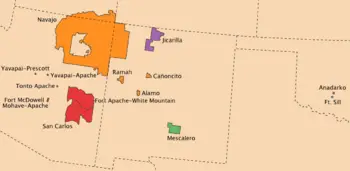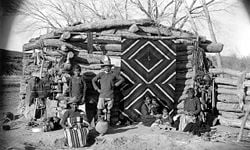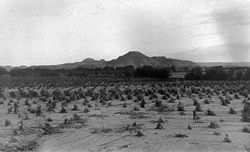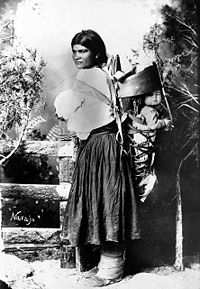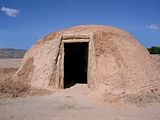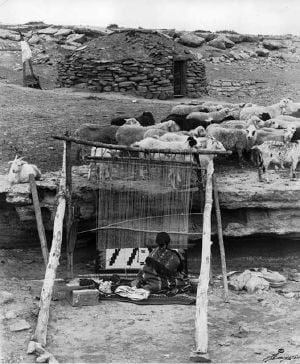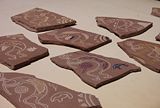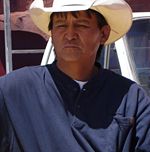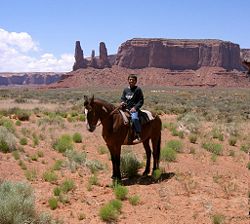Navajo
| Navajo (Diné) |
|---|
| Navajo medicine man |
| Total population |
| 338,443 (2005 census) |
| Regions with significant populations |
| United States (Arizona, New Mexico, Utah, California and Northern Mexico) |
| Languages |
| Navajo, English, Spanish |
| Religions |
| Navajo way, Christianity, Native American Church (NAC), other |
| Related ethnic groups |
| other Southern Athabascan peoples |
The Navajo (also Navaho) people of the southwestern United States call themselves the Diné (pronounced [dɪnɛ]), which roughly means "the people." The Diné of the Southwestern United States are currently the largest native American tribe in North America. They speak the Navajo language, and many are members of the Navajo Nation, an independent government structure which manages the Navajo reservation in the Four Corners area of the United States. The traditional Navajo language is still largely spoken throughout the region, although most Navajo also speak English fluently as well.
Name
The name "Navajo" comes from the late eighteenth century via the Spanish (Apaches de) Navajó "(Apaches of) Navajó," which was derived from the Tewa navahū "fields adjoining a ravine." The Navajo call themselves Diné, which is translated to mean "the people" (most Native American groups call themselves by names that mean "the people"). Nonetheless, most Navajo now acquiesce to being called "Navajo."
Early history
The Navajo speak dialects of the language family referred to as Athabaskan. Athabaskan speakers can also be found living in Alaska through west-central Canada and in a few areas on the Pacific coast. Linguistic and cultural similarities indicate the Navajo and the other Southern Athabaskan speakers (known today as Apaches) were once a single ethnic group (linguistically called Apachean) that probably came from the Great Slave Lake area having crossed the land bridge thousands of years previous. Archaeological and historical evidence suggests these people entered the Southwest after 1000 C.E., with substantial population increases occurring in the 1200s. The Spanish noted the presence of a significant population in the 1500s. Navajo oral traditions are said to retain references of this migration.[1]
Coronado observed Plains people ("dog nomads") wintering near the Pueblos in established camps, who may have included Navajo. In 1540 Coronado reported the modern Western Apache area as uninhabited, yet in the 1580s other Spaniards first mention Apache living west of the Rio Grande who shared corn with them. The early Athabaskan way of life complicates accurate dating, primarily because they constructed less durable dwellings than other Southwestern groups. They also left behind a more austere set of tools and material goods. Sites where early Athabaskans speakers may have lived are difficult to locate, and even more difficult to identify firmly as culturally Athabaskan.
Whenever the Navajo actually arrived, they occupied areas the Pueblos peoples had abandoned during prior centuries. The Navajo people traditionally hold the four sacred mountains as the boundaries of the homeland they should never leave: Blanca Peak (Tsisnaasjini'—Dawn or White Shell Mountain) in Colorado, Mount Taylor (Tsoodzil—Blue Bead or Turquoise Mountain) in New Mexico, the San Francisco Peaks (Doko'oosliid—Abalone Shell Mountain) in Arizona, and Hesperus Mountain (Dibé Nitsaa—Big Mountain Sheep) in Colorado.
Navajo oral history seems to indicate a long relationship with Pueblo people, and a willingness to adapt ideas into their own culture. Trade between the long-established Pueblo peoples and the Athabaskans was important to both groups. The Spanish records say by the mid 1500s, the Pueblos exchanged maize and woven cotton goods for bison meat, hides and material for stone tools from Athabaskans who either traveled to them or lived around them. In the 1700s the Spanish report that the Navajo had large numbers of livestock and large areas of crops. The Navajo probably adapted many Pueblo ideas, as well as practices of early Spanish settlers, into their own very different culture.
The Spanish first use the word Navajo ("Apachu de Nabajo") specifically in the 1620s, referring to the people in the Chama valley region east of the San Juan River and northwest of Santa Fe. By the 1640s, the term Navajo was applied to these same people. The Spanish recorded in 1670s they were living in a region called Dinetah, which was about sixty miles west of the Rio Chama valley region. In the 1780s the Spanish were sending military expeditions against the Navajo in the southwest and west of that area, in the Mount Taylor and Chuska Mountain regions of New Mexico.
Navajos seem to have a history in the last 1000 years of expanding their range, refining their self identity and their significance to others. In short this is probably due to a cultural combination of Endemic warfare(raids) and commerce with the Pueblo, Apache, Ute, Comanche and Spanish people, set in the changing natural environment of the Southwest. Navajo conflicts with European invaders spanned over a 300 year period. From a Navajo perspective, Europeans were considered another tribe. Traditionally, different towns, villages or pueblos were probably viewed as separate tribes or bands by Navajo groups.
The Spanish started to establish a military force along the Rio Grande in the 1600s to the East of Dinetah (the Navajo homeland). Spanish records indicate that Apachean groups (that might include Navajo) allied themselves with the Pueblos over the next 80 years, successfully pushing the Spaniards out of this area following the Pueblo Revolt of 1680. Raiding and trading were part of traditional Apachean and Navajo culture, and these activities increased following the introduction of the horse by the Spaniards, which increased the efficiency and frequency of raiding expeditions. The Spanish established a series of forts that protected new Spanish settlements and also separated the Pueblos from the Apacheans. The Spaniards and later Mexicans recorded what are called punitive expeditions among the Navajo that also took livestock and human captives. The Navajo in turn raided settlements far away in a similar manner. This pattern continued, with the Athapaskan groups apparently growing to be more formidable foes through the 1840s until the American Military arrived in the area.
In 1846, General Stephen W. Kearny invaded Santa Fe with 1,600 men during the Mexican War. The Navajo did not recognize the change of government as legitimate. In September, Kearny sent two detachments to raid and subdue the Navajo. Kearny later took 300 men on an expedition to California from Santa Fe. As they traveled past Navajo homelands, his force lost livestock. He ordered another expedition against the Navajo and this resulted in the first treaty with the United States government in November at Canyon de Chelly.
In the next ten years, the U.S. established forts in traditional Navajo territory. Military records state this was to protect citizens and Navajo from each other. However the old Spanish/Mexican-Navajo pattern of raids and expeditions against one another continued. New Mexican (citizen and militia) raids increased rapidly in 1860–61 earning it the Navajo name Naahondzood, "the fearing time."
In 1861 Brigadier-General James H. Carleton, the new commander of the Federal District of New Mexico, initiated a series of military actions against the Navajo. Colonel Kit Carson was ordered by Gen. J. H. Carleton to conduct expedition into Navajoland and receive their surrender on July 20, 1863. A few Navajo surrendered. Carson was joined by a large group of New Mexican militia volunteer citizens and these forces moved through Navajo land basically killing Navajos and making sure that any Navajo crops, livestock or dwellings were destroyed. Facing starvation, Navajos groups started to surrender in what is known as The Long Walk.
Starting in the spring of 1864, around 9,000 Navajo men, women and children were forced on The Long Walk of over 300 miles to Fort Sumner, New Mexico. This was the largest Reservation attempted by the U.S. government. It was a failure for a combination of reasons: it was designed (water, wood, supplies, livestock) for 4,000–5,000 people, it had one kind of crop failure after another, other tribes and civilians were able to raid the Navajo, a small group of Mescalero Apaches had been moved there, and there was the usual poor planning and/or corruption of the period. In 1868 a treaty was negotiated that allowed the surviving Navajos to return to a reservation that was a portion of their former range.
A Navajo Tribal Police operated between 1872 and 1875 and was used by the Navajo themeselves to stop raiders from their tribe; it was created by Manuelito. In 1883 Lt. Parker took ten enlisted men and two scouts and went up to the San Juan River to separate Navajos and citizens who encroached on Navajo land. Lt. Lockett took 42 enlisted men and no scouts, and were later joined by Lt. Holomon at Navajo Springs. Evidently citizen Houck and/or Owens had murdered a Navajo Chief's son and 100 armed Navajos were looking for them. In 1887, citizens Palmer, Lockhart and King fabricated a charge of horse thievery and attacked a random home on the reservation. Two Navajo men and all three white men died but a woman and a child survived. Capt. Kerr and two Navajo scouts examined the ground and then met with several hundred Navajo at Houcks Tank. Rancher Bennett, whose horse was allegedly stolen, pointed out to Kerr that his horses were stolen by the three white men. Lt. Scott with two scouts and 21 men headed to the San Juan River. The Navajo believed he was there to drive off the whites who had settled on the reservation, and fenced off the river from the Navajo. Scott tells them to wait. He found evidence of many ranches but only three were active and when they refused to leave, wanting payment for their improvements on the land, Scott ejected them with military muscle. In 1890, when a local rancher refused to pay the Navajo a fine of livestock, the Navajos tried to collect it peacefully. White men in southern Colorado and Utah claimed that 9,000 Navajo were on the warpath, so a small military detachment out of Ft. Wingate restored the white citizens to order. The military continued to maintain the forts. Some Navajo were employed by the military as "Indian Scouts" through 1895.
In 1913, an Indian Agent ordered a Navajo and his three wives to come in for questioning, then arrested them for having a plural marriage. A small group of Navajo use force to free the women and retreat to Beautiful Mountain with 30 or 40 sympathizers. They refuse to surrender to the Agent. Local law enforcement and military refuse the Agent's request for an armed engagement. General Scott arrives and with help of Chee Dodge defuses the situation.
By treaty, the Navajo people were allowed to leave the reservation with permission to trade. Raiding by the Navajo essentially stopped, because they were able to increase the size of their livestock and crops, and not have to risk losing them to others. However, while the initial reservation increased from 3.5 million acres (14,000 km²) to the 16 million acres (65,000 km²) of today, economic conflicts with the non-Navajo continued. Civilians and companies raided resources that had been assigned to the Navajo. Livestock grazing leases, land for railroads, mining permits are a few examples of actions taken by agencies of the U.S. government who could and did do such things on a regular basis over the next 100 years. The livestock business was so successful that eventually the United states government decided to kill off most of the livestock in what is known as the Navajo Livestock Reduction.
Culture
Historically, the structure of the Navajo society is largely a matrilocal system in which only women were allowed to own livestock and land. Once married, a Navajo man would move into his bride's dwelling and clan since daughters (or, if necessary, other female relatives) were traditionally the ones who received the generational inheritance (this is mirror-opposite to a patrilocal tradition). Any children are said to belong to the mother's clan and be "born for" the father's clan. The clan system is exogamous, meaning it was, and mostly still is, considered a form of incest to marry or date anyone from any of a person's four grandparents clans.
A hogan is the traditional Navajo home. For those who practice the Navajo religion the hogan is considered sacred. Hogans are sacred and constructed to symbolize their land: the four posts represent the sacred mountains, the floor is mother earth, and the dome-like roof is father sky. The religious song "The Blessingway" describes the first hogan as being built by Coyote with help from beavers to be a house for First Man, First Woman, and Talking God. The Beaver People gave Coyote logs and instructions on how to build the first hogan. Navajos made their hogans in the traditional fashion until the 1900s, when they started to make them in hexagonal and octagonal shapes. Today they are rarely used as actual dwellings, but are maintained primarily for ceremonial purposes.
Arts and craftsmanship
Silversmithing is said to have been introduced to the Navajo while in captivity at Fort Sumner in Eastern New Mexico in 1864. At that time Atsidi Saani learned the silversmithing and began teaching others the craft as well. By the 1880 Navajo silversmiths were creating handmade jewelry including bracelets, tobacco flasks, necklaces, bow guards and eventually evolved into earrings, buckles, bolos, hair ornaments and pins. Turquoise had been used with jewelry by the Navajo for hundreds of years, but they did not do turquoise inlay.
Some early European settlers moved in and set up trading posts, often buying Navajo Rugs by the pound and selling them back east by the bale. Still these traders encouraged the locals to weave blankets and rugs into distinct styles. They included "Two Gray Hills" (predominantly black and white, with traditional patterns), "Teec Nos Pos" (colorful, with very extensive patterns), "Ganado" (founded by Don Lorenzo Hubbell), red dominated patterns with black and white, "Crystal" (founded by J. B. Moore), oriental and Persian styles (almost always with natural dyes), "Wide Ruins," "Chinlee," banded geometric patterns, "Klagetoh," diamond type patterns, "Red Mesa" and bold diamond patterns. Many of these patterns exhibit a fourfold symmetry, which is thought by Gary Witherspoon to embody traditional ideas about harmony or Hozh.
Healing and spiritual practices
Navajo spiritual practice is about restoring health, balance, and harmony to a person's life. One exception to the concept of healing is the Beauty Way ceremony: the Kinaaldá, or a female puberty ceremony. Others include the Hooghan Blessing Ceremony and the "Baby's First Laugh Ceremony." Otherwise, ceremonies are used to heal illnesses, strengthen weakness, and give vitality to the patient. Ceremonies restore Hozhò, or beauty, harmony, balance, and health.
When suffering from illness or injury, Navajos will traditionally seek out a certified, credible Hatałii (medicine man) for healing, before turning to Western medicine (e.g., hospitals). The medicine man will use several methods to diagnose the patient's ailments. This may include using special tools such as crystal rocks, and abilities such as hand-trembling and Hatał (chanting prayer). The medicine man will then select a specific healing chant for that type of ailment. Short blessings for good luck and protection may only take a few hours, and in all cases, the patient is expected to do a follow-up afterwards. This may include the avoidance of sexual relations, personal contact, animals, certain foods, and certain activities; it is not unlike a doctor's advice. This is done to respect the ceremony.
There are said to be approximately 58 to 60 sacred ceremonies. Most of them last four days or more; to be most effective, they require that relatives and friends attend and help out. Outsiders are often discouraged from participating, in case they become a burden on everyone, or violate a taboo. This could affect the turnout of the ceremony. The ceremony must be done in precisely the correct manner to heal the patient, and this includes everyone that is involved.
Medicine men must be able to correctly perform a ceremony from beginning to end. If he does not, the ceremony will not work. Training a Hatałii to perform ceremonies is extensive, arduous, and takes many years, and is not unlike priesthood, with the governing body or hierarchy omitted. The apprentice learns everything by watching his teacher, and memorizes the words to all the chants. Many times, a medicine man cannot learn all 60 of the ceremonies, so he will opt to specialize in a select few.
The origin of spiritual healing ceremonies dates back to Navajo mythology. It is said the first Enemy Way ceremony was performed for Changing Woman's twin sons (Monster Slayer and Born-For-the-Water) after slaying the Giants (the Yé'ii) and restoring Hozhó to the world and people. The patient identifies with Monster Slayer through the chants, prayers, sandpaintings, herbal medicine and dance.
Another Navajo healing, the Night Chant ceremony, is administered as a cure for most types of head ailments, including mental disturbances. The ceremony, conducted over several days, involves purification, evocation of the gods, identification between the patient and the gods, and the transformation of the patient. Each day entails the performance of certain rites and the creation of detailed sand paintings. On the ninth evening a final all-night ceremony occurs, in which the dark male thunderbird god is evoked in a song that starts by describing his home:
- In Tsegihi [White House],
- In the house made of the dawn,
- In the house made of the evening light
- (Sandner, p. 88)
The medicine man proceeds by asking the Holy People to be present, then identifying the patient with the power of the god and describing the patient's transformation to renewed health with lines such as "Happily I recover." (Sandner, p. 90). The same dance is repeated throughout the night, about forty eight times. Altogether the Night Chant ceremony takes about ten hours to perform, and ends at dawn.
Religion
Creation story
The Navajo creation story centers on the area known as the Dinetah, the traditional homeland of the Navajo people. The basic outline of the Navajo creation story is as follows:
Holy Supreme Wind being created the mists of lights arose through the darkness to animate and bring purpose to the myriad Holy People, supernatural and sacred in the different three lower worlds. All these things were spiritually created in the time before the earth existed and the physical aspect of man did not exist yet, but the spiritual did. In the first world the insect people started fighting with one another and were instructed by the Holy People to depart. They journeyed to the second world and lived for a time in peace, but eventually they fought with each other and were instructed to depart.
In the third world the same thing happens again and they are forced to journey to the fourth world. In the fourth world, they found the Hopi living there and succeeded in not fighting with one another or their neighbors, and their bodies were transformed from the insect forms to human forms. Eventually however, they fought with each other again, and again were instructed to depart.
They journeyed to the fifth world and succeeded in not fighting with one another and their bodies were transformed from the insect forms to human forms. First man and First woman physically appear here formed from ears of white and yellow corn, but they were also created back in the beginning. There is a separation of male and female humans because each did not appreciate the contributions of the other, and this laid the groundwork for the appearance of the Monsters that would start to kill off the people in the next world.
Coyote also appears and steals the baby of water monster, who brings a great flood in the third world which primarily forces the humans as well as Holy People to journey to the surface of the fifth world through a hollow reed. Some things are left behind and some things are brought to help the people re-create the world each time they entered a new one. Death and the Monsters are born into this world as is Changing Woman who gives birth to the Hero Twins, called "Monster Slayer" and "Child of the Waters" who had many adventures in which they helped to rid the world of much evil. Earth Surface People, mortals, were created in the fourth world, and the gods gave them ceremonies which are still practiced today. This origin myth forms the basis for the traditional Navajo way of life.
Skin-walkers
In Native American and Norse legend, a skin-walker is a person with the supernatural ability to turn into any animal he or she desires. Similar creatures can be found in numerous cultures' lores all over the world, closely related to beliefs in werewolves (also known as lycanthropes) and other "were" creatures (which can be described as therianthropes).
The ’ánt’įįhnii are human beings who have gained supernatural power by breaking a cultural taboo. Specifically, a person is said to gain the power to become a Yea-Naa-gloo-shee upon initiation into the Witchery Way. Both men and women can become ’ánt’įįhnii and therefore possibly skinwalkers, but men are far more numerous. It is generally thought that only childless women can become witches.
Although it is most frequently seen as a coyote, wolf, owl, fox, or crow, the Yea-Naa-gloo-shee is said to have the power to assume the form of any animal they choose, depending on what kind of abilities they need. Witches use the form for expedient travel, especially to the Navajo equivalent of the 'Black Mass', a perverted sing (and the central rite of the Witchery Way) used to curse instead of to heal. They may also transform to escape from pursuers.
A skin-walker is usually described as naked, except for a coyote skin, or wolf skin. Some Navajos describe them as a mutated version of the animal in question. The skin may just be a mask, like those which are the only garment worn in the witches' sing. Because animal skins are used primarily by skin-walkers, the pelt of animals such as bears, coyotes, wolves, and cougars are strictly tabooed. Sheepskin and buckskin are probably two of the few hides used by Navajos, the latter is used only for ceremonial purposes.
Often, Navajos tell of their encounter with a skin-walker, though there may be some hesitancy to reveal the story to non-Navajos, or (understandably) to talk of such frightening things at night. Sometimes the skin-walker will try to break into the house and attack the people inside, and will often bang on the walls of the house, knock on the windows, and climb onto the roofs. Sometimes, a strange, animal-like figure is seen standing outside the window, peering in. Other times, a skinwalker may attack a vehicle and cause a car accident. The skin-walkers are described as being fast, agile, and impossible to catch. Though some attempts have been made to shoot or kill one, they are not usually successful. Sometimes a skinwalker will be tracked down, only to lead to the house of someone known to the tracker. As in European werewolf lore, sometimes a wounded skinwalker will escape, only to have someone turn up later with a similar wound which reveals them to be the witch. It is said that if a Navajo was to know the person behind the skinwalker they had to pronounce the full name. About three days later that person would either get sick or die for the wrong that they have committed.[2]
According to Navajo legend, skin-walkers can have the power to read human thoughts. They also possess the ability to make any human or animal noise they choose. A skinwalker may use the voice of a relative or the cry of an infant to lure victims out of the safety of their homes.
Traditional Navajo music is always vocal, with most instruments, which include drums, drumsticks, rattles, rasp, flute, whistle, and bullroarer, being used to accompany singing of specific types of song (Frisbie and McAllester 1992). As of 1982, there were over 1,000 Hataałii, or Singers otherwise known as 'Medicine People', qualified to perform one or more of 30 ceremonials and countless prayer rituals (Frisbie and Tso n.d.) which restore hozhó or harmonious condition, good health, serenity, and balance.
These songs are the most sacred holy songs, the "complex and comprehensive" spiritual literature of the Navajo, may be considered classical music (McAllester and Mitchell 1983), while all other songs, including personal, patriotic, daily work, recreation, jokes, and less sacred ceremonial songs, may be considered popular music. The "popular" side is characterized by public performance while the holy songs are preserved of their sacredness by reserving it only for ceremonies (and thus not featured on the recording listed at bottom). (ibid)
The longest ceremonies may last up to nine days and nights while performing rituals that restore the balance between good and evil, or positive and negative forces. The hataałii, aided by sandpaintings or masked yeibicheii, as well as numerous other sacred tools used for healing, chant the sacred songs to call upon the Navajo gods and natural forces to restore the person to harmony and balance within the context of the world forces. In ceremonies involving sandpaintings, the person to be supernaturally assisted, the patient, becomes the protagonist, identifying with the gods of the Diné Creation Stories, and at one point becomes part of the Story Cycle by sitting on a sandpainting with iconography pertaining to the specific story and deities. (McAllester 1981-1982)
The lyrics, which may last over an hour and are usually sung in groups, contain narrative epics including the beginning of the world, phenomenology, morality, and other lessons. Longer songs are divided into two or four balanced parts and feature an alternation of chantlike verses and buoyant melodically active choruses concluded by a refrain in the style and including lyrics of the chorus. Lyrics, songs, groups, and topics include cyclic: Changing Woman, an immortal figure in the Navajo traditions, is born in the spring, grows to adolescence in the summer, becomes an adult in the autumn, and then an old lady in the winter, repeating the life cycles over and over. Her sons, the Hero Twins, Monster Slayer and Born-for-the-Water, are also sung about, for they rid the world of giants and evil monsters. Stories such as these are spoken of during these sacred ceremonies.
The "popular" music resembles the highly active melodic motion of the choruses, featuring wide intervallic leaps and melodic range usually an octave to octave and a half. Structurally, the songs are created from the complex repetition, division, and combinations of most often no more than four or five phrases, with short songs often immediately following each other for continuity as needed in work songs. Their lyrics are mostly vocables, with certain vocables specific to genres, but may contain short humorous or satirical texts. (ibid)
Children's Songs
Navajo children's songs are usually about animals, such as pets and livestock. Some songs are about family members, and about chores, games, and other activities as well. It usually includes anything in a child's daily life. A child may learn songs from an early age from the mother. As a baby, if the child cries, the mother will sing to it while it's tied in the cradleboard. Navajo songs are rhythmic, and therefore soothing to a baby. Thus, songs are a major part of Navajo culture.
It may have been a kind of beginner's course in learning the songs and prayers for self-protection from bad things, most notably coyotes, skinwalkers, and other evil figures in Navajo traditions. Blessings, such as when one does with corn pollen in the early morning, may be learned as well.
In children's songs, a short chant usually starts off the song, followed by at least one stanza of lyrics, and finishing up with the same chant. All traditional songs include chants, and are not made up solely of lyrics. There are specific chants for some types of songs as well. Comtemporary children's songs, however, such as Christmas songs and Navajo versions of nursery rhymes, may have lyrics only. Today, both types of songs may be taught in elementary schools on the reservation, depending on the knowledge and ability of the particular teacher.
In earlier times, Navajo children may have sung songs like these to themselves while sheepherding, to pass the time. Sheep were, and still are, a part of Navajo life. Back then, giving a child custody of the entire herd was a way to teach them leadership and responsibility, for one day they would probably own a herd of their own. A child, idle while the sheep grazed, may sing to pass the time.
Peyote songs
Peyote songs are a form of Native American music, now most often performed as part of the Native American Church, which came to the northern part of the Navajo Nation around 1936. They are typically accompanied by a rattle and water drum, and are used in a ceremonial aspect during the sacramental taking of peyote. Peyote songs share characteristics of Apache music and Plains-Pueblo music. (Nettl 1956, p.114)
In recent years, a modernized version of peyote songs have been popularized by Verdell Primeaux, a Sioux, and Johnny Mike, a Navajo.
Contemporary popular
The Navajo music scene is perhaps one of the strongest in native music today. In the past, Navajo musicians were corraled into maintaining the status quo of traditional music, chants and/or flute compositions. Today, Navajo bands span the genres of punk, metal, hardcore, hip hop, blues, rock, death metal, stoner rock, country, and even traditional. Success of bands like Blackfire, Ethnic De Generation, Downplay, Mother Earth Blues Band, Tribal Live and other musicians have reignited an interest in music with the younger Navajo generations. Perhaps the best synthesis of tradition and contemporary is found in the musical marriage of Tribe II Entertainment, a rap duo from Arizona, Mistic, Rollin, Lil' Spade and Shade are truly right now, the only Native American rappers who can rap entirely in their native tongue. Their popularity and bilingual ability is yet another look at the prolific nature of the Navajo music scene.
The Navajo Nation (Diné) encompasses all things important to the Navajo—the land, kinship, language, religion, and the right to govern themselves. The Navajo Homeland covers about 26,000 square miles (70,000 square kilometres, 17 million acres) of land, occupying all of northeastern Arizona, and extending into Utah and New Mexico, and is the largest land area assigned primarily to a Native American jurisdiction within the United States.
Diné government is unique in several ways. The Navajo Nation is divided into five Agencies. These are similar to counties and match the five Bureau of Indian Affairs (BIA) agencies which support the Nation. The smallest political units are the Chapters, similar to towns. The Navajo Nation Council presently consists of 88 delegates representing the 110 Chapters, elected every four years by registered Navajo voters. As reorganized in 1991, the Nation's government at the capital in Window Rock has a three branch system: Executive, Legislative, and Judicial. The United States still asserts plenary power to require the Navajo Nation to submit all proposed laws to the United States Secretary of the Interior for Secretarial Review, through the Bureau of Indian Affairs.
The Navajo governing council continues a historical practice of prohibiting alcohol sales within reservation boundaries. For some visitors of the area — often attracted by the Indian jewelry trade, by tourist attractions or by Interstate Highway 40 that passes through the area. Leaders and some member groups actively oppose the sale of alcohol, and have taken several measures to find and offer treatment for those members who are suffering from alcoholism.
There is no private land ownership within the Navajo Nation - all land is owned in common and administered by the Nation's government. Leases are made both to customary land users (for homesites, grazing, and other uses) and to organizations, including the BIA and other federal agencies, churches and other religious organizations, and businesses.
The Navajo Nation economy includes traditional endeavors such as sheep and cattle herding, fiber production, weaving, jewelry making, and art trading. Newer industries that employ members include coal and uranium mining, though the uranium market slowed near the end of the twentieth century. The Navajo Nation's extensive mineral resources are among the most valuable held by Native American nations within the United States. The Navajo government employs hundreds in civil service and administrative jobs. One important business within the reservation is the operation of arts and crafts shops, selling handmade crafts. Other Navajo members work at retail stores and other businesses within the Nation's reservation or in nearby towns. Until 2004, the Navajo Nation had declined to join other Native American (indigenous) nations within the United States who have opened casinos. That year, the nation signed a compact with the state of New Mexico to operate a casino at To'hajiilee, near Albuquerque. Navajo leaders also negotiated with Arizona state officials in talks that could lead to casinos near Flagstaff, Lake Powell, Winslow, Sanders (Nahata Dziil Chapter), and Cameron (Grand Canyon entrance).
"Hooghan," means the home for Navajos and it is the center of learning, and the traditional style of home of the Navajo is the hogan. Most modern housing in the Navajo Nation is detached single-family homes and mobile homes. Most homes in the Navajo Nation were built in the 1960s, 1970s, or 1980s, although older built homes do exist. Single-family homes are mostly rural-styled homes constructed of wood. Because many homes do not have access to natural gas and electricity, most homes use wood or propane for heat and cooking.
Due to the reservation's remote geographic location, many structures do not have telephone or public utility services and lack complete kitchen or plumbing facilities. However, infrastructure development has grown significantly through the years, affording Navajo families the modern conveniences of DSL, satellite television and even wireless access in some communities. The government subsidized phone program has brought even the most remote locations of the reservation in contact with the rest of the Navajo Nation.
The Navajo Nation operates Diné College, a two-year community college which has its main campus in Tsaile in Apache County, as well as seven other campuses on the reservation. Current enrollment is 1,830 students, of which 210 are degree-seeking transfer students for four-year institutions. The college includes the Center for Diné Studies, whose goal is to apply Navajo Sa'ah Naagháí Bik'eh Hózhóón principles to advance quality student learning through Nitsáhákees (thinking), Nahatá (planning), Iiná (living), and Sihasin (assurance) in study of the Diné language, history, and culture in preparation for further studies and employment in a multi-cultural and technological world.
Notes
- ↑ For example, the Great Canadian Parks website suggests that the Navajo may be descendants the lost Naha tribe, a Slavey tribe from the Nahanni region west of Great Slave Lake. Nahanni National Park Reserve. Great Canadian Parks. Retrieved 2007-07-02.
- ↑ Kluckhohn, p.27
Bibliography
- Bailey, L. R. (1964). The Long Walk: A History of the Navaho Wars, 1846–1868.
- Bighorse, Tiana. (1990). Bighorse the Warrior. Ed. Noel Bennett, Tucson: University of Arizona Press.
- Brown, Dee (1970). Bury My Heart at Wounded Knee. ISBN 0-330-23219-3.
- Brugge, David M. (1968). Navajos in the Catholic Church Records of New Mexico 1694–1875. Window Rock, Arizona: Reseach Section, The Navajo Tribe.
- Clarke, Dwight L. (1961). Stephen Watts Kearny: Soldier of the West. Norman, Oklahoma: University of Oklahoma Press a
- Downs, James F. (1972). The Navajo. New York: Holt, Rinehart, and Winston.
- Dyke, Walter (1967). Son of Old Man Hat. Lincoln, Nebraska: Bison Books & University of Nebraska Press. LCCN 44-2654.
- Forbes, Jack D. (1960). Apache, Navajo and Spaniard. Norman, OK: University of Oklahoma Press. LCCN 60-13480.
- Gilpin, Laura. (1968). The Enduring Navaho. Austin: University of Texas Press.
- Gold, Peter (1994). Navajo & Tibetan Sacred Wisdom: The Circle of the Spirit. Rochester, Vermont: Inner Traditions International. ISBN 0-89281-411-X. .
- Hammond, George P. and Rey, Agapito (editors) (1940). Narratives of the Coronado Expedition 1540–1542. Albuquerque: University of New Mexico Press.
- Henderson, Richard.(1994). “Replicating Dog Travois Travel on the Northern Plains.” Plains Anthropologist, V39:145–59
- Iverson, Peter. (2002). Diné: A History of the Navahos. Albuquerque: University of New Mexico Press. ISBN 0-8263-2714-1
- Kelly, Lawrence (1970). Navajo Roundup, Pruett Pub. Co., Colorado.
- Kluckholm, Clyde & Leighton, Dorothea (1946). The Navaho. Cambridge: Oxford University Press.
- Loewen, James. W. (1999). Lies Across America. Pages 100–101; The New Press.
- McNitt, Frank. (1972). Navajo Wars. Albuquerque: University of New Mexico Press.
- Newcomb, Franc Johnson (1964). Hosteen Klah: Navajo Medicine Man and Sand Painter. Norman, Oklahoma: University of Oklahoma Press. LCCCN 64-20759.
- Plog, Stephen. Ancient Peoples of the American Southwest. Thames and London, LTD, London, England, 1997. ISBN 0-500-27939-X.
- Compiled (1973). Roessel, Ruth (editor). Navajo Stories of the Long Walk Period. Tsaile, Arizona: Navajo Community College Press.
- Compiled (1974). in Roessel, Ruth: Navajo Livestock Reduction: A National Disgrace. Tsaile, Arizona: Navajo Community College Press. ISBN 0-912586-18-4.
- Terrell, J. U. (1970). The Navajos.
- Underhill, Ruth M. (1956). The Navahos. Norman: The University of Oklahoma Press.
- Witherspoon, Gary. (1977). Language and Art in the Navajo Universe. Ann Arbor: University of Michigan Press.
- Salmonson, Jessica Amanda.(1991) The Encyclopedia of Amazons. Paragon House. Page 255. ISBN 1-55778-420-5
- Zolbrod, Paul G. Diné bahané: The Navajo Creation Story. Albuquerque: University of New Mexico Press, 1984.
- Kluckhohn, Clyde. Navaho Witchcraft. Beacon Press, Boston, 1944. Library of Congress cat. No. 62-13533
- Wall, Leon and William Morgan. Navajo-English Dictionary. (Hippocrene Books, New York City, 1998 ISBN 0-7818-0247-4
- Young, Robert W. and William Morgan. Colloquial Navajo, a Dictionary. Hippocrene Books, New York City, 1998 ISBN 0-7818-0278-4
- Wall, Leon and William Morgan, Navajo-English Dictionary. (Hippocrene Books, New York City, 1998 ISBN 0-7818-0247-4)
- Brady, M.K., Some Kind of Power: Navaho Children's Skinwalker Narratives. (University of Utah Press, Salt Lake City, 1984 ISBN 0-87480-238-5)
- Marika, K.. Werewolves, Shapeshifters and Skinwalkers. (Sherbourne Press, Los Angeles, 1972)
- Teller, J. The Navajo Skinwalker, Witchcraft, & Related Spiritual Phenomena: Spiritual Clues: Orientation to the Evolution of the Circle. Infinity Horn Publishing, Chinle AZ, 1997 ISBN 0-9656014-0-4)
- Kluckhohn, Clyde. Navaho Witchcraft. Beacon Press, Boston, 1944. Library of Congress cat. No. 62-13533
External links
- Middle Ground Project of Northern Colorado University with images of U.S. documents of treaties and reports 1846–1931
- Navajo People information by State of Utah
- A Brief Overview of the Navajo People (as of October 18, 2004)
- Navajo Silversmiths, by Washington Matthews, 1883 from Project Gutenberg
- Navajo Institute for Social Justice
- Navajo Jewelry Information
- Navajo Artcrafts Website created by students of GreyHills Academy High School in Tuba City AZ.
- Navajo weaving
- Historic Collection of Navajo Pictures
- Spanish-Navajo dictionary on line AULEX
- Navajo Tourism Website for the Navajo Tourism Department
- Non-Profit Navajo Arts & Crafts Enterprise
- Navajo Witches—Skinwalkers
- Skinwalkers
- Navajo Skinwalkers
- Rare carving of a Skin Walker
- American Werewolves in Folklore and Mythology
Credits
New World Encyclopedia writers and editors rewrote and completed the Wikipedia article in accordance with New World Encyclopedia standards. This article abides by terms of the Creative Commons CC-by-sa 3.0 License (CC-by-sa), which may be used and disseminated with proper attribution. Credit is due under the terms of this license that can reference both the New World Encyclopedia contributors and the selfless volunteer contributors of the Wikimedia Foundation. To cite this article click here for a list of acceptable citing formats.The history of earlier contributions by wikipedians is accessible to researchers here:
- Navajo_people history
- Navajo_mythology history
- Navajo_music history
- Witch_(Navajo) history
- Skin-walker history
The history of this article since it was imported to New World Encyclopedia:
Note: Some restrictions may apply to use of individual images which are separately licensed.
